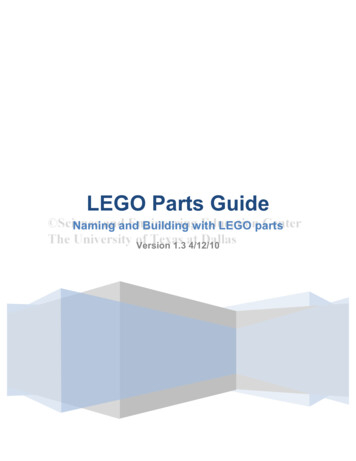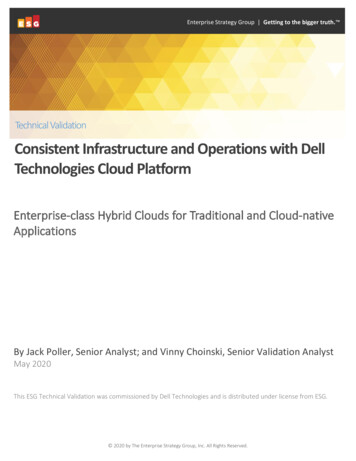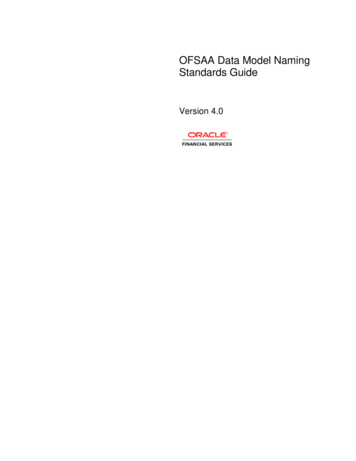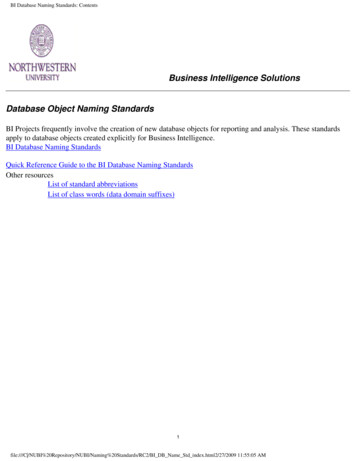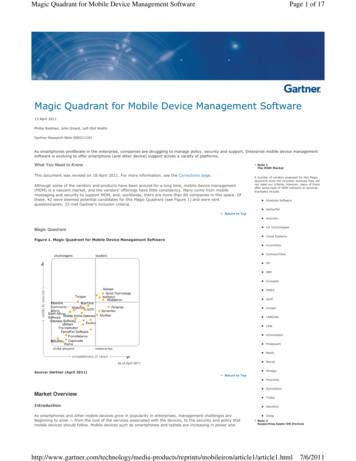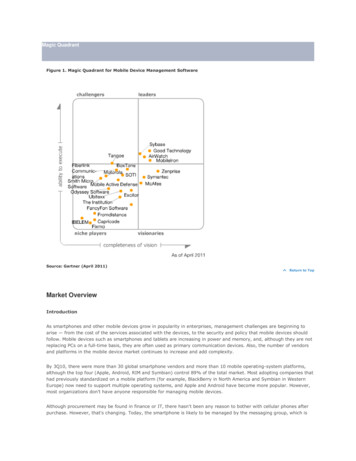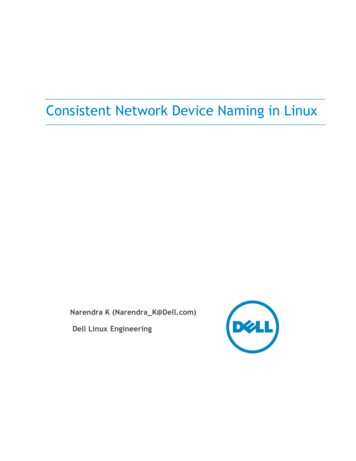
Transcription
Consistent Network Device Naming in LinuxNarendra K (Narendra K@Dell.com)Dell Linux Engineering
Consistent Network Device Naming in LinuxThis document is for informational purposes only and may contain typographical errors andtechnical inaccuracies. The content is provided as is, without express or implied warranties of anykind. 2012 Dell Inc. All rights reserved. Dell and its affiliates cannot be responsible for errors or omissionsin typography or photography. Dell, the Dell logo, and PowerEdge are trademarks of Dell Inc. Othertrademarks and trade names may be used in this document to refer to either the entities claiming themarks and names or their products. Dell disclaims proprietary interest in the marks and names ofothers.July 2012 Rev 1.4ii
Consistent Network Device Naming in LinuxContentsIntroduction . 5The new naming scheme . 5Firmware information that “biosdevname” utilizes to suggest new names . 5Dell Systems that support the new network naming . 6RHEL 6.1 notes . 7Getting the new naming scheme to work on your system . 8Prerequisites . 8Building and installing biosdevname from source tar ball . 8Installing biosdevname from RPMs . 9Building biosdevname from source rpm . 9New naming built into operating system . 9Enable/disable the new naming scheme . 9During install time . 9Reverting to the traditional „ethN‟ naming scheme . 10Applications/Scripts using hardcoded „ethN‟ names . 10Examples: . 10Naming scheme for network interfaces from SRIOV virtual functions . 11Naming scheme for network interfaces from NIC partitions (NPAR) . 11Contribution . 12More Information. 12Mailing Lists . 12References . 12TablesTable 1.Dell systems that support the new network naming . 6iii
Consistent Network Device Naming in Linuxiv
Consistent Network Device Naming in LinuxIntroductionModern x86-based Servers support an increasing number of network interface ports on the motherboardin addition to add-in network adapters. Linux-based OSes name these interfaces as ethN. The namingof network interfaces is currently non-deterministic and not governed by any standard in terms of theirrelationship to the way the ports are wired on the system. Common user expectations such as 'eth0'representing the first network port on the motherboard as labeled on the server chassis cannot befulfilled in many cases.Ensuring that the Ethernet interface names follow the order of the devices as intended by the systemdesigner might not be sufficient. The “ethN” names currently in use do not suggest the Ethernetinterface‟s physical location, whether it is on the system‟s motherboard or if it is on an add-in card; orif it is on an add-in card with multiple ports, which port on the card it is on.Consequently, a naming mechanism that can impart meaning to the network interface‟s name based onthe physical location of a network port in concordance to the intended system design is necessary. Toachieve this, the system firmware has the ability to communicate the intended order for networkdevices on the motherboard to the Operating System via standard mechanisms such as SMBIOS andACPI.The new naming scheme, using the 'biosdevname' udev helper utility developed by Dell and releasedunder GPL, suggests new names based on the location of the network adapters on the system assuggested by system BIOS.The new naming schemeLan-On-Motherboard interfacesem port number virtual function instance / NPAR Index (ethernet-on-motherboard 1,2 . )PCI add-in interfacesp slot number p port number virtual function instance / NPAR Index Firmware information that “biosdevname” utilizes to suggest new namesThe system BIOS indicates the order of Onboard Network Devices to the OS via SMBIOS type 41 records.The system BIOS provides „system slot information‟ to the OS via type 9 records. The biosdevnamemakes use of SMBIOS type 41 to suggest names to the onboard network devices and type 9 records tosuggest new names for PCI add-in adapters.The biosdevname falls back on PCI IRQ Routing Table in the absence of the above mentionedinformation.5
Consistent Network Device Naming in LinuxDell Systems that support the new network namingTable 1.System ModelDell M910R210R210 T110 ll PrecisionR5400T3500Dell systems that support the new network namingRHEL 6.1SLES 11 XXXXXXXXXXXXXXXXXXXX--6
Consistent Network Device Naming in PowerEdge C SeriesC1100C2100C6100C6105C6145XXX-XXX---Notes:1. Systems with „-‟ under RHEL 6.1 have their system BIOS implementing SMBIOS version 2.5 and2.4, hence biosdevname will not suggest new names in RHEL 6.12. Naming SRIOV virtual functions which belong to the Lan-On-Motherboard devices is notsupported.RHEL 6.1 notes In RHEL 6.1, system BIOS should implement SMBIOS Version 2.6 Type 41 and Type 9records for the biosdevname to suggest new names. biosdevname will not fall back toPCI IRQ Routing Table and new names will not be suggested in the absence of SMBIOSVersion 2.6 compliant system BIOS. NPAR device naming is not supported in RHEL 6.1. The support for naming NPAR devicesis included in RHEL 6.2.7
Consistent Network Device Naming in LinuxGetting the new naming scheme to work on your systemPrerequisitesThe system BIOS should implement SMBIOS Version 2.6 type 41 and type 9 tables. If they are notavailable, the system BIOS should expose a PCI IRQ Routing Table.To check if BIOS implements SMBIOS type 41:# /sbin/dmidecode –t 41To check if BIOS implements SMBIOS type 9:# /sbin/dmidecode –t 9To check if BIOS implements PCI IRQ Routing Table:# /sbin/biosdecodeNote: RHEL 6.1 requires SMBIOS version 2.6 to use the new naming scheme.Building and installing biosdevname from source tar ballbiosdevname can be built from sources available for download link/git://linux.dell.com/biosdevname.git1. Prerequisites: pciutils-devel and zlib-devel2. Build and install biosdevname tar zxvf biosdevname- latest version .tar.gz cd biosdevname- latest version ./configure sudo make && make install3. Remove /etc/udev/rules.d/70-persistent-net.rulesThis file contains existing interface names for persistency across reboots. If this file exists, thebiosdevname will not kick in.4. Rename ifcfg-ethN files to ifcfg-emN and ifcfg-p*. The content of these files is distributionspecific. Please modify the fields that contain the interface name to reflect the new namesAs an example ifcfg-ethN files in RHEL 6.1 contain a „DEVICE ‟ field which will be assigned withthe ethN name. Please modify it to suit the new naming scheme such as „DEVICE em1‟8
Consistent Network Device Naming in LinuxIf the ifcfg-ethN file embeds interface hardware address, please comment it as biosdevnamesuggests a name based on the location of the adapter on the mother board5. Reboot the systemInstalling biosdevname from RPMsThe biosdevname can be installed using RPMSs built for the distribution you are using. For example:Fedora 15:# rpm –ivh biosdevname-0.3.8-1.fc15.x86 64.rpmRHEL 6.1:# rpm –ivh biosdevname-0.3.6-11.el6.x86 64.rpmBuilding biosdevname from source rpmThe biosdevname rpm can be built from the source rpm tes: pciutils-devel and zlib-devel# rpm –ivh biosdevname- latest version -1.src.rpm# rpmbuild –bb path-to-biosdevname.spec file On Fedora-based distributions, this is under /rpmbuild/SPECS. On SuSE based distributions, this is/usr/src/packages/SPECS# rpm –ivh path-to-biosdevname-binary-rpm New naming built into operating systemIf the OS has biosdevname support built in, then the new naming scheme is enforced by default duringinstall time and run time on supported Dell systemsFor a list of Linux Distributions where biosdevname is integrated into the installer, see Table 1.Enable/disable the new naming schemeIf you choose not to use the new naming scheme, it can be turned off during install time or post-installtime.During install timeTo disable the use of the new naming scheme, during installation (attended or automated), pass thekernel command line parameter biosdevname 0 on the boot command line. The parameter should bepassed on the boot command line after installation to ensure that a new network adapter plugged inpost installation has a traditional „eth‟ name.9
Consistent Network Device Naming in LinuxNote: On SLES 11 SP2 biosdevname 0 needs to be passed to boot command line only duringinstallation.Certain distributions (see Table 1) have enabled the new naming scheme on all Dell systems by defaultand disabled for others. If you choose to use the new naming scheme on non-Dell systems with suchdistributions, set biosdevname 1 in the kernel command line during install.Reverting to the traditional „ethN‟ naming schemeIn case you have a system with the new naming scheme and would like to revert to the traditionalnaming scheme:1. Rename all ifcfg-emN and ifcfg-p* configuration files and modify the contents of the filesaccordingly. The content of these files is distribution specific (see /usr/share/doc/initscripts version for details)As an example ifcfg-ethN files in RHEL 6.1 contain a „DEVICE ‟ field which will be assigned withthe emN name. Modify it to suit the new naming scheme such as „DEVICE eth0‟.2. Comment the HWADDR variable in the ifcfg-eth* files if present as it is not possible to predicthere which of the network devices will be named eth0, eth1 etc.3. Reboot the system4. Login and you should see the ethN names.The 70-persistent-net.rules file will be created under /etc/udev/rules.d/ to make the namespersistent across reboots.Applications/Scripts using hardcoded „ethN‟ namesIf an application expects network interface names to be of the form ethN, then it might fail. Pleasereport it via the distribution‟s bug tracking system.Examples:On a PowerEdge R710 with Four Broadcom BCM 5709 Lan-On-Motherboard ports One Intel 82572EI single port network adapter on PCI slot 4 One Intel 82576 dual port network adapter on PCI slot 3The naming of the network interfaces would be:[root@per710 ]# ls /sys/class/net/em1 em2 em3 em4 lo p3p1 p3p2 p4p1Using the new naming scheme[root@per710 ]# ifconfig em110
Consistent Network Device Naming in Linuxem1Link encap:Ethernet HWaddr 00:24:E8:2E:DE:FFinet addr:172.16.66.166 Bcast:172.16.127.255 Mask:255.255.192.0 [root@per710 ]# ethtool -i p3p2 0driver: igbvfversion: 1.0.8-k0firmware-version: N/Abus-info: 0000:07:10.1Name for interfaces of Intel 82572EI single port network adapter on PCI slot 4p4p1This conveys that the interface is from the network adapter on PCI slot 4 and port 1Naming scheme for network interfaces from SRIOV virtual functionsThe interface names for virtual functions exposed by SRIOV adapters, like the Intel 82576 networkadapter, would be as follows (assuming that we enable two virtual functions per physical function):[root@per710 ]# ls /sys/class/net/em1 em2 em3 em4 lo p3p1 p3p1 0 p3p1 1 p3p2 p3p2 0 p3p2 1 p4p1Physical functioninterface nameVirtual functioninterface namesexposed by 'p3p1'p3p1p3p1 0p3p1 1p slot 3 p port number 1 p slot 3 p port number 1 virtual function instance 0 Virtual function instance 0 of port 1 of PCI add-in networkadapter on SLOT 3p slot 3 p port number 1 virtual function instance 1 (Virtual function instance 1 of port 1 of PCI add-in networkadapter on SLOT 3)Naming scheme for network interfaces from NIC partitions (NPAR)The interface names for NIC partitions exposed by NPAR-capable devices, like the BCM 57800 NDC(Network Daughter Card) with two NPAR-capable 10G ports, on a PowerEdge R620 would be:[root@PowerEdge-R620 ]# ls /sys/class/net/em1 1 em1 2 em2 1 em2 2 em3 em4 lo p3p1 p3p2NPAR disabledem1em2NPAR enabledem1 1 – em port 1 NPAR Index 1 em1 2 – em port 1 NPAR Index 2 em2 1– em port 2 NPAR Index 1 11
Consistent Network Device Naming in Linuxem2 2– em port 2 NPAR Index 2 ContributionYour contribution in making biosdevname achieve its purpose comprehensively would be invaluable. Test b
R210 X X R210 II X X R310 X X R410 X X R415 X X R510 X X R515 X X R610 X X R710 X X R715 X X R810 X X . PowerEdge C Series C1100 - - C2100 - - C6100 - - C6105 - - C6145 - - Notes: 1. Systems with „-‟ under RHEL 6.1 have their system BIOS implementing SMBIOS version 2.5 and 2.4, hence biosdevname will not suggest new names in RHEL 6.1 2. Naming SRIOV virtual functions which

